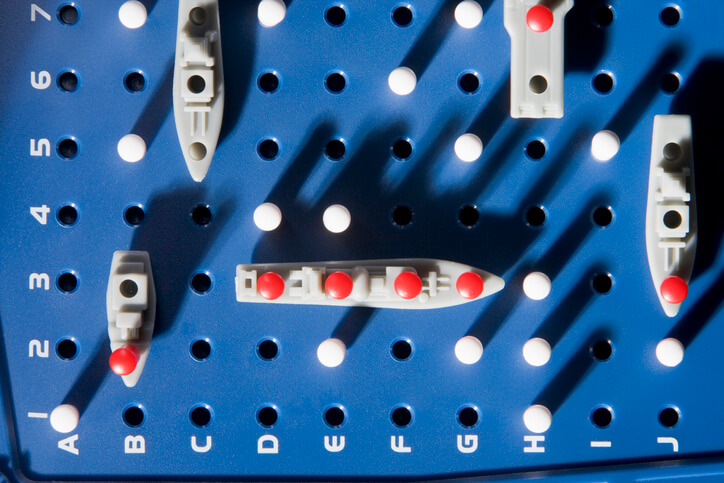Remember board games? In a world where playing a game often means staring at a screen, it can be easy to forget how we used to entertain ourselves.
If you’re feeling nostalgic for the days of low-tech amusement, consider breaking out some of your favorite board games from the past. Although some games have been eclipsed by more recent releases, many of those that were popular in the 1950s, ’60s, and ’70s are still well-known today.
1
Battleship
This game is well-known, even among people who never tried their luck, thanks to the classic TV commercial and the cry “You sank my battleship!”
Battleship originated as a European WWI-era paper and pencil game. The game so many Americans grew up playing was released in the 1960s. Players of the guessing game covertly arrange their ships on a plastic grid and take turns trying to guess the position of their opponent’s ships so they can sink them.
2
Candy Land
Sure, Candy Land is simple. But the game, designed for very young children who lack strong reasoning and decision-making abilities, can be fun for adults too.
What could be more of a mindless escape than following easy directions through a brightly colored world where places have names such as Molasses Swamp and Candy Castle?
3
Clue
Was it Mrs. Peacock in the conservatory with the rope? Or perhaps, Colonel Mustard in the lounge with the candlestick?
Before the cult film of the same name, which combined a murder mystery with the unease of the McCarthy era, there was the game. (It’s known as Cluedo outside of North America).
This story of whodunit, where and how casts players as suspects represented by colored pawns or figurines. The movie had three alternate endings, but the game has 324! The best part? Even if you’re the killer, you might not know it until the very end.
4
Life
Life’s plastic peg people drive their tiny cars around the board, attempting to reach the milestones of conventional success.
Playing this game as an adult might be less amusing than it was as a child (Who wants to go bankrupt, even if it’s just pretend?), but what Life lacks in escapism, it makes up for in nostalgia.
Fun Fact:
The modern version of Life (a.k.a. The Game of Life) came out in 1960. Its predecessor, The Checkered Game of Life, was invented a century earlier—and it wouldn’t have happened if Abraham Lincoln hadn’t grown a beard. (Life’s inventor, lithographer Milton Bradley, came up with the game out of sheer desperation after his best-selling image, that of a clean-shaven Lincoln, stopped selling when the president changed his look.)
5
Monopoly
Invented in 1903 as an economics lesson, the game’s colorful money and Get Out of Jail Free card have become bywords in American culture.
You may not recall all the details of Monopoly’s real estate transactions, but you probably have a preference for one of the game’s iconic pieces, like the little car or shoe. (You might also have a strong opinion about Monopoly’s publisher retiring the iron.)
Although there is a seemingly endless array of themed versions, attempting to accumulate hotels on Baltic Avenue or Park Place is sure to bring back memories.
Fun Fact:
If you think the game takes forever, it might be because you—like most people—have been playing Monopoly wrong. For example, if you land on a property and choose not to buy it, that doesn’t automatically mean it’s the next player’s turn. According to Hasbro’s official rules, the Banker is to sell that property at auction to the highest bidder, which will, somehow, make the game go faster.
6
Operation
Anyone who has played Operation even once will recognize the buzzing sound the game makes when a player isn’t dexterous enough with the tweezers.
This battery-operated 1960s game, in which players are doctors attempting to remove organs without touching the edges of the “body cavity,” is funny, frustrating and disturbing.
One factor that makes this game perfect for the easily distracted populace of the 21st century is its playing time: You can get through a game of Operation in just ten minutes. But although it’s straightforward, it’s not easy.
7-9
Parcheesi, Sorry!, and Trouble
These board games are modern variations on the ancient Indian cross and circle game Pachisi.
Parcheesi was released in the United States in the late 19th century and Sorry! in the 1930s. In both modern games, players try to beat each other as they navigate their pieces around the board—although the boards and other equipment are rather different.
Many around the world play similar Pachisi-derived games. A simpler version you might know is Trouble. Do you remember the so-called “Pop-O-Matic” bubble in the center of its board, which players press with a satisfying click to roll the die.
10
Risk
This geopolitical strategy game, invented in 1957, might have introduced you to the notion that a game could represent a serious reality.
Whether you were the type to capture continents alone or to form fearsome alliances, the great thing about Risk was that unlike real life, the consequences weren’t serious. If your army failed to conquer a territory or your alliance dissolved, you could simply stuff your map and troops back in their box and go get a snack.
11
Scrabble
If you loved language, you might have enjoyed combining Scrabble’s square tiles, each marked with a letter, to spell out words.
This timeless game is simple, consisting of tiles, the racks they stand on and the grid on which players compete to create words worth the most points.
Scrabble is one of those rare board games that is both educational and contentious. Rules can be tricky to agree on in a game where you resolve disputes with a dictionary and triple word scores can make or break your point total.
12
Numble
If you preferred numbers to letters, you may have been a bigger fan of Scrabble’s mathematically inclined cousin.
Rather than create words as in Scrabble, Numble players arrange their tiles in sequences of ascending or descending numerical order.
This sounds like a mindless exercise, but there’s a catch: The total of any sequence has to be divisible by three. Your memories of this one might be hazy, but anyone with experience playing Numble knows it can get intense.
13
Trivial Pursuit
Even though it came out in 1982, Trivial Pursuit feels like a game that’s been around forever.
There’s something very serious about this game, with its blue boxes full of questions. Answering these questions, divided into categories such as Geography and History, is what most people think of when they recall playing Trivial Pursuit. But there’s a whole other component to the game—the board. This is where players maneuver their game pieces as they attempt to remember facts like the scientific name for a rabbit’s tail (a scut).
The wonderful thing about board games standing the test of time is that people of all generations can find them enjoyable. So, while you’re rediscovering your old favorites, try introducing them to others in your life. To you, they’re nostalgic, but to younger or older friends and relatives, they’ll be brand new.
What’s Your Favorite Game?
Help other readers choose which game to play next. Let us know your favorites in the comments below.







My favorites checkers, chess and i still have my electric football game with all pieces
#longb4maddeneasports
I love Dominoes and Scrabble still to this day. Keeps your mind moving constantly, love card games as well.
We played Monopoly almost all summer in the basement of our home as children in the 1940’s and 1950’s. I still have our original game.
Trivial Pursuit and Othello.
As a kid in the 50s our family played Sorry and Chutes and Ladders. Also worked on jigsaw puzzles later on.
I’ve been a backgammon junkie for many years and enter tournaments across the country.